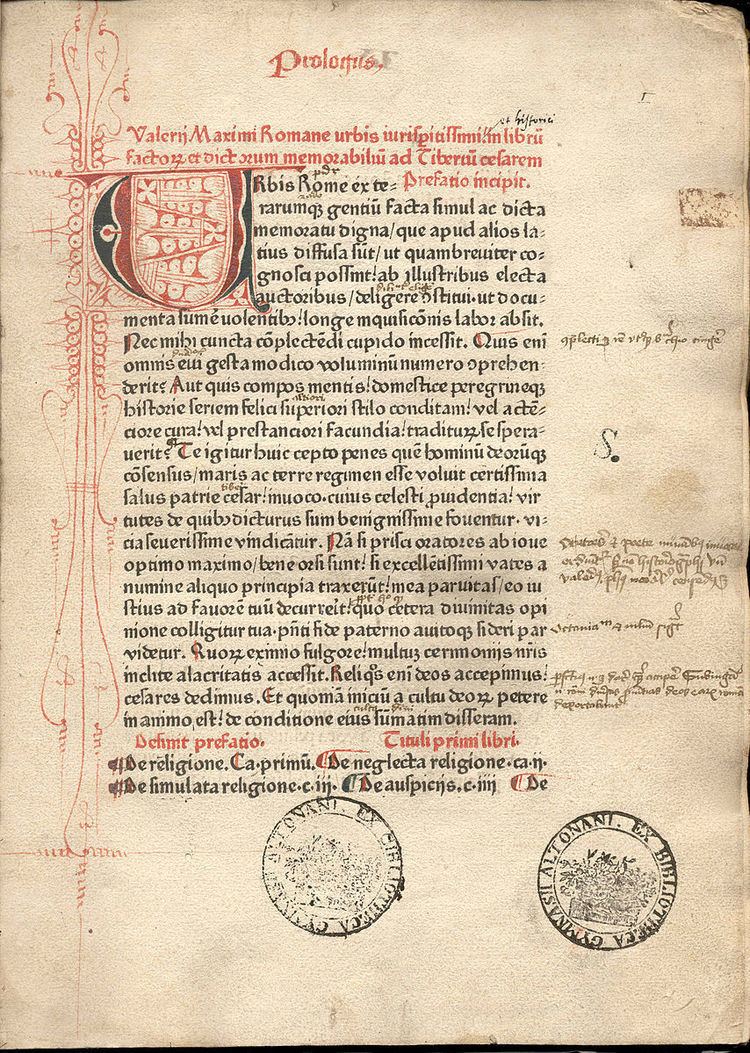 | ||
An incunable, or sometimes incunabulum (plural incunables or incunabula, respectively), is a book, pamphlet, or broadside (such as the Almanach cracoviense ad annum 1474) that was printed—not handwritten—before the year 1501 in Europe. "Incunable" is the anglicised singular form of "incunabula", Latin for "swaddling clothes" or "cradle", which can refer to "the earliest stages or first traces in the development of anything." A former term for "incunable" is "fifteener", referring to the 15th century.
Contents
It has often been said and that the first recorded use of incunabula as a printing term would be in the Latin pamphlet De ortu et progressu artis typographicae ("On the rise and progress of the typographic art", Cologne, 1639) by Bernhard von Mallinckrodt, which includes the phrase prima typographicae incunabula, "the first infancy of printing", a term to which he arbitrarily set an end of 1500 which still stands as a convention. But since 2009 we know that this lexical invention should no more be assigned to Mallinckrodt : dated 1569, it has to be credited to the Dutch Physician Hadrianus Junius (Adriaan de Jonghe, 1511/1512-1575). In his "Batavia", published in Leiden in 1588 but written in 1569, Junius used the term "incunabula" referring to the time of the first productions of the typographic technique : "...id observatum fuerat inter prima artis incunabula". The term came to denote the printed books themselves in the late 17th century. John Evelyn, in moving the Arundel Manuscripts to the Royal Society in August 1678, remarked of the printed books among the manuscripts: "The printed books, being of the oldest impressions, are not the less valuable; I esteem them almost equal to MSS." The convenient but arbitrarily chosen end date for identifying a printed book as an incunable does not reflect any notable developments in the printing process, and many books printed for a number of years after 1500 continued to be visually indistinguishable from incunables. "Post-incunable" typically refers to books printed after 1500 up to another arbitrary end date such as 1520 or 1540.
As of 2014, there are about 30,000 distinct incunable editions known to be extant, while the number of surviving copies in Germany alone is estimated at around 125,000.
Types
There are two types of incunabula in printing: the Block book printed from a single carved or sculpted wooden block for each page, employing the same process as the woodcut in art (these may be called xylographic), and the typographic book, made with individual pieces of cast metal movable type on a printing press. Many authors reserve the term incunabula for the typographic ones only.
The spread of printing to cities both in the north and in Italy ensured that there was great variety in the texts chosen for printing and the styles in which they appeared. Many early typefaces were modelled on local forms of writing or derived from the various European forms of Gothic script, but there were also some derived from documentary scripts (such as most of Caxton's types), and, particularly in Italy, types modelled on handwritten scripts and calligraphy employed by humanists.
Printers congregated in urban centres where there were scholars, ecclesiastics, lawyers, nobles and professionals who formed their major customer base. Standard works in Latin inherited from the medieval tradition formed the bulk of the earliest printing, but as books became cheaper, works in the various local vernaculars (or translations of standard works) began to appear.
Famous examples
The most famous incunabula include the Gutenberg Bible of 1455, the Peregrinatio in terram sanctam of 1486—printed and illustrated by Erhard Reuwich—both from Mainz, the Nuremberg Chronicle written by Hartmann Schedel and printed by Anton Koberger in 1493, and the Hypnerotomachia Poliphili printed by Aldus Manutius with important illustrations by an unknown artist. Other printers of incunabula were Günther Zainer of Augsburg, Johannes Mentelin and Heinrich Eggestein of Strasbourg, Heinrich Gran of Haguenau and William Caxton of Bruges and London. The first incunable to have woodcut illustrations was Ulrich Boner's Der Edelstein, printed by Albrecht Pfister in Bamberg in 1461.
Statistical data
The data in this section were derived from the Incunabula Short-Title Catalogue (ISTC).
Major collections
The British Library's Incunabula Short Title Catalogue now records over 29,000 titles, of which around 27,400 are incunabula editions (not all unique works). Studies of incunabula began in the 17th century. Michel Maittaire (1667–1747) and Georg Wolfgang Panzer (1729–1805) arranged printed material chronologically in annals format, and in the first half of the 19th century, Ludwig Hain published, Repertorium bibliographicum— a checklist of incunabula arranged alphabetically by author: "Hain numbers" are still a reference point. Hain was expanded in subsequent editions, by Walter A. Copinger and Dietrich Reichling, but it is being superseded by the authoritative modern listing, a German catalogue, the Gesamtkatalog der Wiegendrucke, which has been under way since 1925 and is still being compiled at the Staatsbibliothek zu Berlin. North American holdings were listed by Frederick R. Goff and a worldwide union catalogue is provided by the Incunabula Short Title Catalogue.
Notable collections, with the approximate numbers of incunabula held, include:
Post-incunable
The end date for identifying a printed book as an incunable is convenient but was chosen arbitrarily; it does not reflect any notable developments in the printing process around the year 1500. Books printed for a number of years after 1500 continued to look much like incunables, with the notable exception of the small format books printed in italic type introduced by Aldus Manutius in 1501. The term post-incunable is sometimes used to refer to books printed "after 1500—how long after, the experts have not yet agreed." For books printed in Europe, the term generally covers 1501–1540, and for books printed in the UK, 1501–1520.
